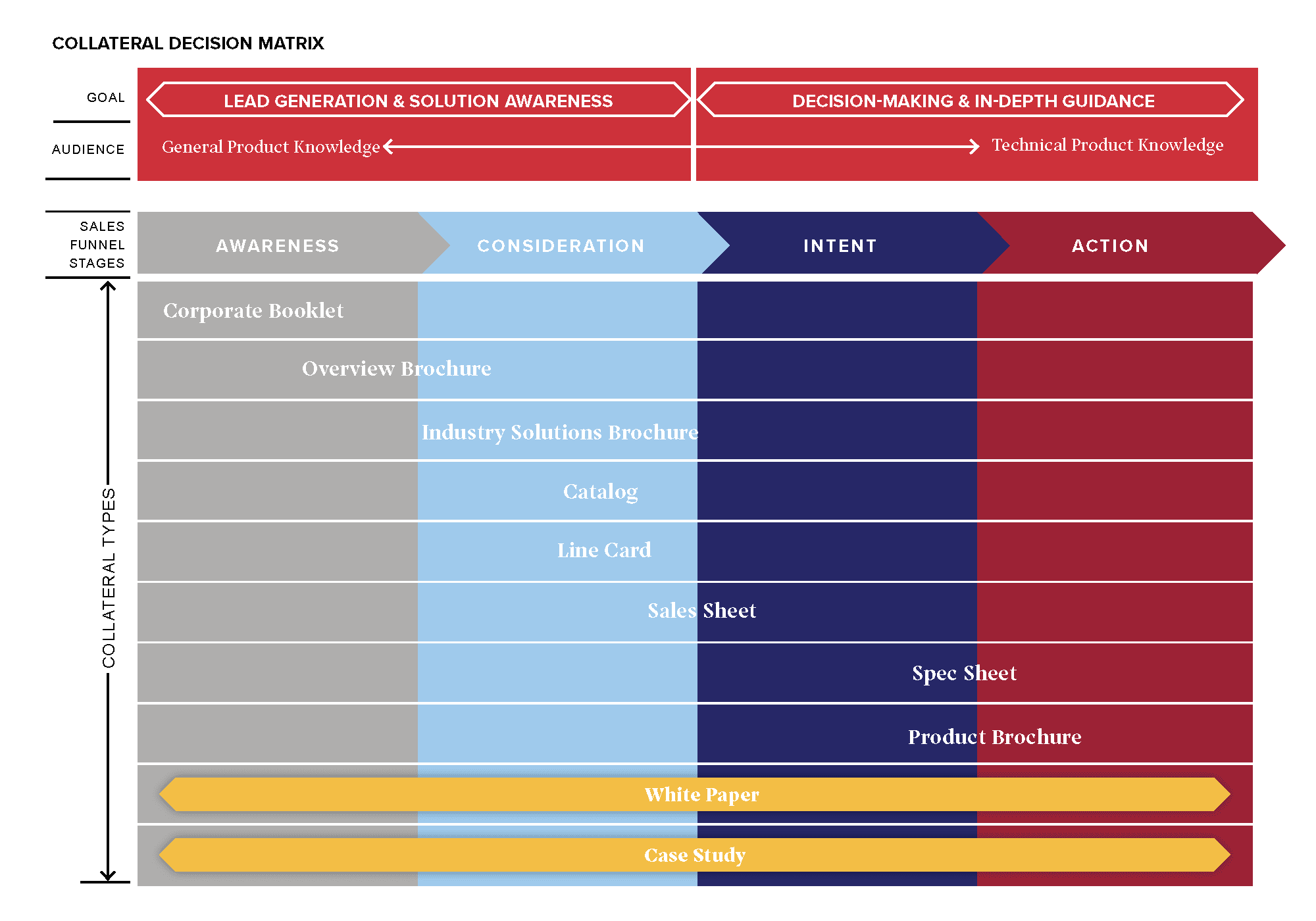Marketing departments don't always fully recognize the distinction between marketing collateral and sales collateral, often to the detriment of the organization's marketing and sales outcomes. Well-designed marketing collateral typically brings consumers to your business. It educates consumers about your brand and the value it provides and focuses less on a specific product or service.
Marketing collateral, such as blog posts or infographics, may focus on the range of products and services you provide as well as their quality. But in many cases, marketing collateral may not even mention your product/service line; instead functioning to position your brand as a credible, authentic, and trusted authority in your industry. An industry white paper, for example, might highlight current trends and unique insights about your field that showcases your expertise, making it easier for consumers to trust your eventual sales messages. The best marketing collateral convinces consumers, whether business or individual, that they would truly benefit from using your services instead of your competition and drives consumers to learn how they can do so.
By contrast, sales material should sell a specific product or service. Sales collateral should identify a consumer's problem and illustrate how your product/service solves it better than your competition. Whether you're selling a line of bakery products to a grocery chain or packaging equipment to a manufacturing plant manager,you have to give them the information they need to decide to buy.
Your sales collateral will vary based on your audience. A product brochure might help a consumer to lease a new apartment, while a case study may be enough to convince an up-and-coming hotel to use your media and influencer relations PR services. But no matter the target audience, sales collateral educates the prospective customer about the product to compel them to buy, whereas marketing collateral connects the prospective customer to your brand, priming them for eventual purchase.
Developing a collateral strategy
It's not enough to understand this distinction. You have to put it into practice. That doesn't always mean creating wholly separate pieces. But it does mean ensuring that each piece you design helps the consumer along each stage of the buyer's journey: Awareness, Consideration, Decision, and if ongoing customer service is part of your business — Delight. The Collateral Decision Matrix is a useful infographic that demonstrates what type of collateral you can use throughout each stage of the buyer's journey.

Different pieces are useful for different purposes. A corporate brochure is best for brand awareness, not sales efforts. Similarly, a product brochure focuses on your product, not your brand. Some, such as an industry brochure, may serve dual capacities. But it's best to map out the pieces you require according to the information consumers need at each stage and designing each set of collateral accordingly.
Marketing collateral is best aligned with the awareness stage of the consumer journey. What does that mean in practical terms? It means you're communicating to a broad audience over multiple channels. Ideally, you communicate using bite-sized messages that audiences can easily digest. Written content is good, but rich content, such as visual, audio, and video, is usually better.
You'll want to avoid content stuffed to the brim with sales messages, which may put people off. Further, content solely focused on your brand and company will become stale quickly. Instead, create marketing collateral that provides value to the consumer. A visual blog post with well-sourced facts and figures or infographic can help consumers recognize your industry knowledge and seek out more insights. These types of marketing collateral help deepen awareness of your brand and position your company as an authority.
Sales collateral is aligned more closely with the Consideration and Decision stages of the consumer journey. Here is where you identify or reaffirm the consumer's problem and present your product/service as the best possible solution. Again, here visual content helps tremendously. Even if you're selling sophisticated technical products, photos or videos of them in action can help consumers visualize using them and predispose them more favorably to buy. Depending on the product, written case studies, line cards, sales sheets, spec sheets, and product brochures can be very effective. But to cut through the marketing clutter, incorporate striking visuals to bring your product or service to life.
Think about what questions prospective customers ask at each stage. Talk to your sales team for insights about what information they may need to move them to the next stage. Develop a roadmap for your marketing and sales collateral based on what information consumers seek at each stage, ensuring that each piece is optimized to push them further along. If you've done so effectively, you'll find the consumer purchase decision-making process takes less time, as well as an increase in sales, which is the ultimate goal.
Phase 3 can help you ideate and implement your collateral strategy. We'll look at your existing materials and data and then work with you to create a collateral roadmap that suits your target audience. We'll help you design a visual system that expresses your brand and handle your printing needs in a cost-effective manner that allows you to stretch your marketing dollars further. Contact us today, and let us help streamline the way you connect with your customers.

